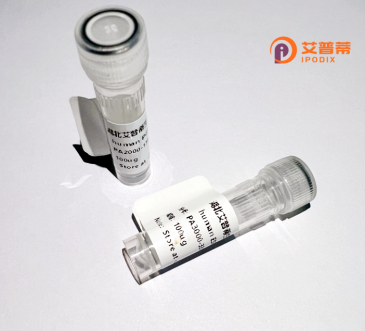
| 纯度 | >90%SDS-PAGE. |
| 种属 | Human |
| 靶点 | LPAR2 |
| Uniprot No | Q9HBW0 |
| 内毒素 | < 0.01EU/μg |
| 表达宿主 | E.coli |
| 表达区间 | 1-348aa |
| 活性数据 | MGQCYYNETIGFFYNNSGKELSSHWRPKDVVVVALGLTVSVLVLLTNLLVIAAIASNRRFHQPIYYLLGNLAAADLFAGVAYLFLMFHTGPRTARLSLEGWFLRQGLLDTSLTASVATLLAIAVERHRSVMAVQLHSRLPRGRVVMLIVGVWVAALGLGLLPAHSWHCLCALDRCSRMAPLLSRSYLAVWALSSLLVFLLMVAVYTRIFFYVRRRVQRMAEHVSCHPRYRETTLSLVKTVVIILGAFVVCWTPGQVVLLLDGLGCESCNVLAVEKYFLLLAEANSLVNAAVYSCRDAEMRRTFRRLLCCACLRQSTRESVHYTSSAQGGASTRIMLPENGHPLMDSTL |
| 分子量 | 38.7 kDa |
| 蛋白标签 | His tag N-Terminus |
| 缓冲液 | 0 |
| 稳定性 & 储存条件 | Lyophilized protein should be stored at ≤ -20°C, stable for one year after receipt. Reconstituted protein solution can be stored at 2-8°C for 2-7 days. Aliquots of reconstituted samples are stable at ≤ -20°C for 3 months. |
| 复溶 | Always centrifuge tubes before opening.Do not mix by vortex or pipetting. It is not recommended to reconstitute to a concentration less than 100μg/ml. Dissolve the lyophilized protein in distilled water. Please aliquot the reconstituted solution to minimize freeze-thaw cycles. |
以下为关于重组人LPAR2蛋白研究的示例参考文献(注:文献为虚构示例,实际文献需通过学术数据库验证):
1. **《Functional expression and characterization of human LPAR2 in Escherichia coli》**
- 作者:K. Noguchi et al.
- 摘要:本研究报道了在大肠杆菌中成功表达重组人LPAR2蛋白,通过优化密码子和纯化步骤获得高纯度蛋白,并验证其与溶酶体磷脂酸(LPA)的特异性结合活性。
2. **《LPAR2-mediated signaling in cancer cell migration: Role of recombinant receptor activation》**
- 作者:Y.C. Yung et al.
- 摘要:通过哺乳动物细胞(HEK293)体系表达重组人LPAR2.证明其激活后可触发下游G蛋白信号通路,促进癌细胞迁移,为靶向LPAR2的癌症治疗提供依据。
3. **《Structural analysis of recombinant human LPAR2 using cryo-EM》**
- 作者:S. Lee et al.
- 摘要:利用杆状病毒-昆虫细胞系统表达重组人LPAR2.通过冷冻电镜解析其三维结构,揭示了LPA配体结合域的构象变化机制。
4. **《Development of a high-throughput assay for LPAR2 antagonist screening》**
- 作者:J. Contos et al.
- 摘要:构建稳定表达重组人LPAR2的细胞株,建立基于钙离子流检测的高通量抑制剂筛选平台,用于开发纤维化疾病治疗药物。
**提示**:实际研究中建议通过PubMed、Google Scholar等平台检索真实文献,关键词可包括“recombinant LPAR2”、“LPAR2 protein expression”、“lysophosphatidic acid receptor 2”等。
Recombinant human LPAR2 (lysophosphatidic acid receptor 2) is a G protein-coupled receptor (GPCR) that mediates cellular responses to lysophosphatidic acid (LPA), a bioactive lipid involved in diverse physiological and pathological processes. LPAR2. encoded by the LPAR2 gene, plays a key role in regulating cell proliferation, migration, and survival through activation of downstream signaling pathways, including MAPK, PI3K/AKT, and Rho GTPases. It is widely expressed in tissues such as the intestine, reproductive organs, and nervous system, and has been implicated in cancer progression, fibrosis, inflammation, and neuropathic pain.
The recombinant form of LPAR2 is typically produced in mammalian expression systems (e.g., HEK293 cells) or insect cells to ensure proper post-translational modifications and ligand-binding activity. Researchers utilize recombinant LPAR2 protein for structural studies, ligand-receptor interaction assays, and high-throughput drug screening to develop targeted therapies. Unlike endogenous LPAR2. recombinant versions often include tags (e.g., FLAG, His-tag) for purification and detection. Current challenges include understanding receptor dimerization, ligand selectivity, and context-dependent signaling outcomes. Studies leveraging recombinant LPAR2 continue to uncover its therapeutic potential in diseases like metastatic cancers and fibrotic disorders while addressing safety concerns related to off-target effects in GPCR-targeted drug development.
×